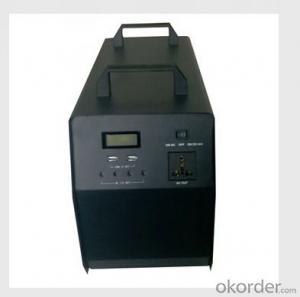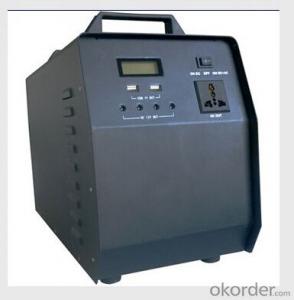Solar Home System Small Solar System 500W
- Loading Port:
- Shanghai
- Payment Terms:
- TT or LC
- Min Order Qty:
- 10000 set
- Supply Capability:
- 5000000 set/month
OKorder Service Pledge
OKorder Financial Service
You Might Also Like
Introduction of Solar Home System
Solar Home System is composed by Solar Panels, Inverters, Charger Controller, Battery, Cable, Mounting Bracket, which is applied to produce electricity for home use.
Solar Home System is quite suitable product in urban area and the place which is short of electricity. As the cost of solar products reduced, more and more family can bear the charge of solar products. These products apply to schools, hospitals, public halls and private housing, communication stations, weather station. Also can use as household appliances, lighting, communications equipment, meteorological equipment.
Our company’s main target is to make every family can use cheap solar energy and enjoy the new innovation of modern science and technology.
Picture of Our Factory

Working Principle of Solar Home System
This is an off-grid solar system which uses batteries to store the solar energy, at the same time, the solar system can be connected with the grid for utilization of grid power. The solar system uses battery power in priority, but when sunshine is not so good or loads consumption is too big which caused the battery power inadequacy, then the system can switch automatically to grid power supply. Meanwhile, the system can charge the batteries with grid power until batteries are fully charged. Then the solar system will switch back to battery power supply.
Product Details of Solar Home System
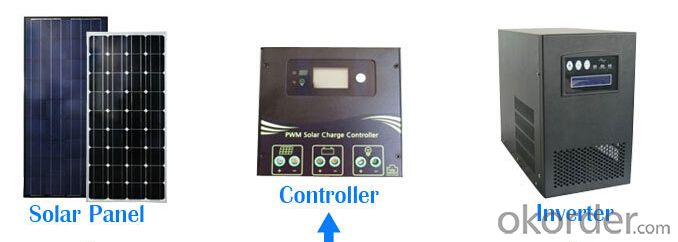
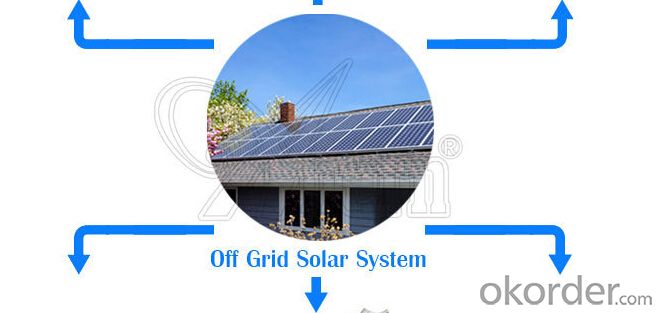

Working Principle of Solar Home System
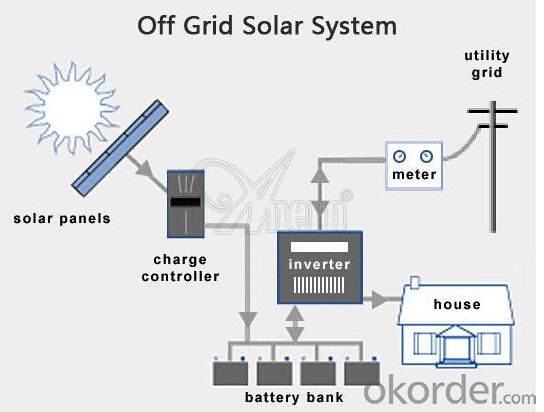
Specification of Solar Home System
Technical data: | |||||||||
Inverter | Rated load power | 500W | |||||||
Output wave | modify sine wave | ||||||||
Input voltage | 12V | ||||||||
Output voltage | DC:12V | ||||||||
Output frequency | 50HZ/60HZ | ||||||||
Precision of output frequency | ±6% | ||||||||
Solar panel | Pmax | 60W | |||||||
Vmp | 17.5V | ||||||||
Imp | 3.429A | ||||||||
Charger | Charger voltage & current | 12V10A | |||||||
Battery | Capacity | 12V38AH | |||||||
Power box | Spray paint iron box, input, output, ammeter, voltmeter, master switch and so on | ||||||||
Package data: | |||||||||
Part | Size (L*W*H mm) | Weight (kg) | 20' (pcs) | 40' (pcs) | |||||
Power box | 520*220*430 | 35 | 140Sets | 320Sets | |||||
Solar panel | 790*700*50 | 7 | |||||||
Solar panel bracket |
|
| |||||||
Loading electrical equipment(For consult) | |||||||||
Name of Load | Power(W) | Quantity | Working Time per Day (H) | Working Days | |||||
Color TV | 65W | 1 | 1 | 2 days | |||||
Satellite TV Receivers | 25W | 1 | 1 | 2 days | |||||
lamp | 11W | 2 | 6 | 2 days | |||||
Other | 150W |
| 1 | 2 days | |||||
Advantage of Our Solar Home System
1 Excellent Performance: Our Solar Home System is composed by Brand Standard Kits with high quality. Our solar system has the advantage of high efficiency and stable operation. We can ensure our product with a long life period.
2. Small Orders Accepted: We can accept small orders as our customer’s trial order.
3. Guarantee/Warranty: We supply 10 Years Product Warranty and 25 Years Performance warranty.
4. Warehouse: We have warehouse overseas which can bring great convenience to our customer to pick up the products.
- Q:How do solar energy systems impact the structural integrity of a building?
- Solar energy systems do not significantly affect a building's structural integrity. They are specifically engineered to be installed on rooftops or as standalone structures without compromising stability. The weight of solar panels is relatively light, and advancements in technology have made them even lighter. Panels are typically mounted on racks or frames to evenly distribute the weight across the surface area. Additionally, professional engineers assist in the installation of roof-mounted solar panels to ensure the load is properly distributed and does not exceed the roof's weight-bearing capacity. Furthermore, solar panels act as a protective layer for the roof, shielding it from direct sunlight, rain, and other weather conditions. This protection extends the roof's lifespan by preventing UV damage and reducing thermal stress caused by extreme temperatures. In certain cases, additional reinforcement may be necessary, particularly for older buildings or areas prone to seismic activity or heavy snow loads. However, experienced professionals consider these factors during the installation process. Overall, solar energy systems have an insignificant impact on a building's structural integrity and can even enhance roof protection. They are designed to be secure, dependable, and long-lasting, promoting the stability and sustainability of the building.
- Q:What is the role of charge controllers in a solar energy system?
- The role of charge controllers in a solar energy system is to regulate and control the flow of electricity between the solar panels and the battery bank. They ensure that the batteries are charged efficiently and protect them from overcharging or discharging, thus prolonging their lifespan. Charge controllers also prevent the solar panels from backfeeding into the grid during low or no-load conditions, ensuring safety and compliance with electrical regulations.
- Q:Can solar panels be used to power agricultural irrigation systems?
- Yes, solar panels can be used to power agricultural irrigation systems. Solar energy can be converted into electricity, which can then be used to power pumps and other irrigation equipment. This sustainable and renewable energy source offers a cost-effective and environmentally friendly solution for powering irrigation systems in remote and off-grid areas.
- Q:How much space do I need for a solar energy system?
- The space required for a solar energy system depends on various factors such as the size of the system, the amount of energy needed, and the efficiency of the solar panels. In general, for a residential solar energy system, you would need a roof space of about 100-400 square feet per kilowatt (kW) of solar panels. However, there are alternative options like ground-mounted systems or solar canopies that can be used if roof space is limited. It is recommended to consult with a solar energy professional who can assess your specific energy needs and available space to determine the appropriate size and configuration of the system.
- Q:How does the tilt angle of solar panels affect their performance?
- The tilt angle of solar panels greatly affects their performance. The optimal tilt angle allows the panels to capture the maximum amount of sunlight throughout the day, maximizing their energy production. If the tilt angle is too low, the panels may not receive enough sunlight, leading to lower efficiency. Similarly, if the tilt angle is too high, the panels may receive excessive sunlight in certain hours, causing the energy production to decrease. Therefore, finding the right tilt angle is crucial for maximizing the performance and energy output of solar panels.
- Q:What is the impact of roof age on the performance of solar panels?
- The age of a roof can impact the performance of solar panels in several ways. Firstly, an older roof may have structural issues or damage that could affect the installation of solar panels. Additionally, an aging roof may have worn or deteriorated shingles, which could lead to leaks or water damage that can harm the solar panel system. Moreover, an older roof may not have been designed to accommodate the weight of solar panels, potentially leading to structural instability. Therefore, it is essential to assess the condition and age of the roof before installing solar panels to ensure optimal performance and longevity of the system.
- Q:How much space is needed for installing solar panels?
- The amount of space needed for installing solar panels depends on various factors such as the type and size of the panels, the energy requirements, and the available sunlight. Generally, a typical residential solar panel system requires around 100-400 square feet of roof space per kilowatt of installed capacity. However, ground-mounted systems can require larger areas. It is best to consult with a solar installer to determine the specific space requirements for your situation.
- Q:What are the maintenance requirements for solar energy systems?
- Solar energy systems have varying maintenance requirements based on their type and size. In general, solar panels are easy to maintain and require minimal upkeep. However, there are a few important tasks that can enhance the system's performance and lifespan. Regular cleaning of the solar panels is essential. Accumulation of dust, dirt, leaves, and other debris on the panel surface can lower their efficiency. By using a soft cloth or gentle water spray, the build-up can be removed, maximizing energy production. Another crucial maintenance task involves checking the wiring and connections of the solar system. Over time, wires may become loose or damaged, impacting system performance. Regular inspections and tightening of connections can prevent issues and ensure smooth operation. Monitoring the system's performance is also vital. Most solar systems are equipped with monitoring software, allowing homeowners to track energy production and identify potential problems. Regular monitoring helps detect any decline in performance or malfunctioning components, enabling timely repairs or replacements. Additionally, it is advisable to have a professional inspection of the solar energy system every few years. A qualified technician can thoroughly assess components like panels, inverters, and batteries (if present), identifying signs of wear or damage and addressing them before they escalate. Overall, solar energy systems have relatively low maintenance requirements. However, regular cleaning, checking connections, monitoring performance, and periodic professional inspections are crucial for optimal functioning and longevity.
- Q:Can solar energy systems be used for powering communication systems?
- Yes, solar energy systems can be used to power communication systems. Solar panels can generate electricity from sunlight, which can then be used to power various communication devices such as cell towers, radios, satellites, and even remote communication systems in areas with limited access to the grid. This use of solar energy not only provides a sustainable and renewable source of power but also helps in reducing reliance on fossil fuels and minimizing the environmental impact of communication systems.
- Q:Can solar energy systems be used in areas with limited government support?
- Yes, solar energy systems can be used in areas with limited government support. In fact, solar energy is a viable and sustainable option for regions that lack government incentives or financial aid. The decreasing costs of solar technology and the availability of off-grid systems make it feasible for individuals, communities, and businesses to adopt solar energy independently. Additionally, with the advancement of innovative financing models like community solar projects and microgrids, solar power can be accessible and affordable even in areas with limited government assistance.
1. Manufacturer Overview |
|
|---|---|
| Location | |
| Year Established | |
| Annual Output Value | |
| Main Markets | |
| Company Certifications | |
2. Manufacturer Certificates |
|
|---|---|
| a) Certification Name | |
| Range | |
| Reference | |
| Validity Period | |
3. Manufacturer Capability |
|
|---|---|
| a)Trade Capacity | |
| Nearest Port | |
| Export Percentage | |
| No.of Employees in Trade Department | |
| Language Spoken: | |
| b)Factory Information | |
| Factory Size: | |
| No. of Production Lines | |
| Contract Manufacturing | |
| Product Price Range | |
Send your message to us
Solar Home System Small Solar System 500W
- Loading Port:
- Shanghai
- Payment Terms:
- TT or LC
- Min Order Qty:
- 10000 set
- Supply Capability:
- 5000000 set/month
OKorder Service Pledge
OKorder Financial Service
Similar products
New products
Hot products
Hot Searches
Related keywords

